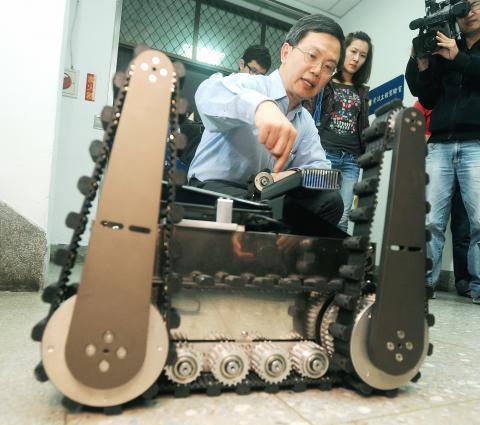A research team from National Taiwan Normal University (NTNU) has invented a robot that can carry out automated nighttime surveillance, climb stairs and move freely around buildings, the team announced yesterday.
The team was comprised of researchers from the school’s Computational Intelligence and Robotics Lab and led by Wang Wei-yen (王偉彥), a chair professor in the Department of Applied Electronics Technology.
It took the team three years to develop the robot, named “NTNU-CIR-I,” which is capable of carrying out surveillance patrols in complicated landscapes during the day and at night.

Photo: Lin Cheng-kung, Taipei Times
The team said the robot was meant to fill the gap in the security of school campuses that are open to the public after class hours. The robot can patrol areas that are not patrolled so often by campus security and that the scope of mounted surveillance cameras cannot reach.
Many other robots rely on four wheels to move and are thereby limited to flat surfaces, but the NTNU-CIR-I was designed to overcome this limitation by employing highly sensitive sensors to detect and navigate past obstacles, even in the dark, Wang said, adding that it can also calculate the angles of slopes or stairs to adjust its movements as it climbs.
The team said they think the robot could be a useful addition to security systems in factories, buildings and campuses because it can transmit real-time footage through the Internet.
It could also be used for educational purposes, such as though the application of its sensors, motor control, image processing and intelligence algorithm design, the team added.
Wang was awarded the titles of Institute of Electrical and Electronics Engineers Fellow and Institution of Engineering and Technology Fellow this year for his contribution to the field of robotics, the school said, adding that the team is applying for a patent for the robot.

Three Taiwanese airlines have prohibited passengers from packing Bluetooth earbuds and their charger cases in checked luggage. EVA Air and Uni Air said that Bluetooth earbuds and charger cases are categorized as portable electronic devices, which should be switched off if they are placed in checked luggage based on international aviation safety regulations. They must not be in standby or sleep mode. However, as charging would continue when earbuds are placed in the charger cases, which would contravene international aviation regulations, their cases must be carried as hand luggage, they said. Tigerair Taiwan said that earbud charger cases are equipped

Foreign travelers entering Taiwan on a short layover via Taiwan Taoyuan International Airport are receiving NT$600 gift vouchers from yesterday, the Tourism Administration said, adding that it hopes the incentive would boost tourism consumption at the airport. The program, which allows travelers holding non-Taiwan passports who enter the country during a layover of up to 24 hours to claim a voucher, aims to promote attractions at the airport, the agency said in a statement on Friday. To participate, travelers must sign up on the campaign Web site, the agency said. They can then present their passport and boarding pass for their connecting international

UNILATERAL MOVES: Officials have raised concerns that Beijing could try to exert economic control over Kinmen in a key development plan next year The Civil Aviation Administration (CAA) yesterday said that China has so far failed to provide any information about a new airport expected to open next year that is less than 10km from a Taiwanese airport, raising flight safety concerns. Xiamen Xiangan International Airport is only about 3km at its closest point from the islands in Kinmen County — the scene of on-off fighting during the Cold War — and construction work can be seen and heard clearly from the Taiwan side. In a written statement sent to Reuters, the CAA said that airports close to each other need detailed advanced

WEATHER Typhoon forming: CWA A tropical depression is expected to form into a typhoon as early as today, the Central Weather Administration (CWA) said yesterday, adding that the storm’s path remains uncertain. Before the weekend, it would move toward the Philippines, the agency said. Some time around Monday next week, it might reach a turning point, either veering north toward waters east of Taiwan or continuing westward across the Philippines, the CWA said. Meanwhile, the eye of Typhoon Kalmaegi was 1,310km south-southeast of Oluanpi (鵝鑾鼻), Taiwan’s southernmost point, as of 2am yesterday, it said. The storm is forecast to move through central